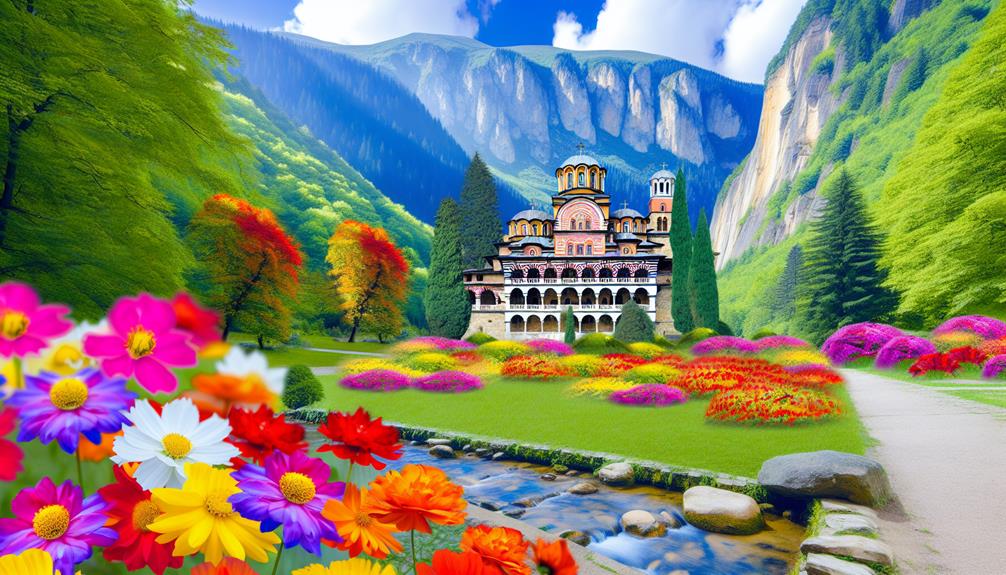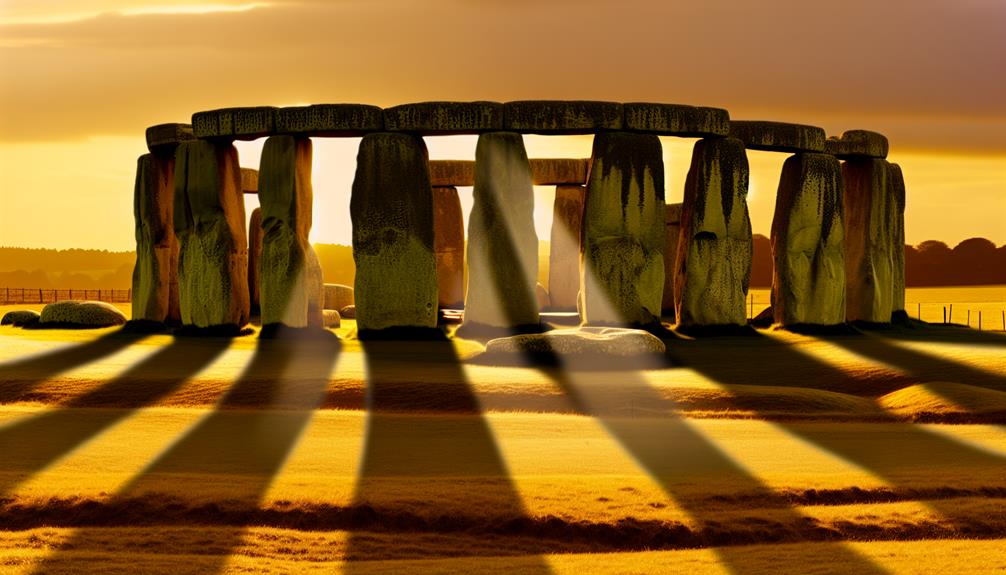Nestled within the tranquil embrace of the Rila Mountains, Rila Monastery stands as a proof of centuries of history and spiritual devotion. The monastery's intricate architecture and rich frescoes tell tales of a bygone era, drawing visitors into a world where time seems to stand still. Beyond its physical beauty lies a deeper connection to traditions and beliefs that have shaped the region for generations. As one explores the depths of Rila Monastery's past, a profound sense of reverence and wonder awaits, inviting exploration into the heart of Bulgaria's cultural and religious heritage.
Key Takeaways
- Founded in the 10th century by Saint John of Rila.
- Architectural blend of Gothic revival and Byzantine styles.
- Monastic life emphasizes spiritual discipline and communal living.
- Surrounded by the natural beauty of Rila Mountains.
- Hosts cultural events and conservation projects for preservation.
History of Rila Monastery
The historical roots of Rila Monastery in Bulgaria trace back to the 10th century, showcasing a rich tapestry of religious, cultural, and architectural significance. Founded by Saint John of Rila, a hermit who sought solitude in the Rila Mountains, the monastery served as a spiritual retreat and a center of religious life in medieval Bulgaria. Its establishment marked the beginning of a long-standing tradition of monasticism and learning in the region.
During the medieval period, Rila Monastery flourished as a hub of spirituality, attracting monks and pilgrims seeking solace and enlightenment. The monastery's remote location amidst the breathtaking natural beauty of the Rila Mountains provided the perfect setting for spiritual contemplation and prayer. The monks dedicated themselves to a life of prayer, work, and study, fostering a deep sense of community and devotion.
Over the centuries, Rila Monastery evolved into a significant cultural and religious institution, playing a pivotal role in preserving Bulgarian heritage and traditions. Its architectural style, characterized by intricate frescoes and wood-carved decorations, reflects the artistic achievements of the time. The monastery's enduring legacy as a spiritual haven continues to draw visitors from around the world, seeking to experience the tranquility and majesty of this medieval marvel.
Architectural Marvels
Nestled within the serene embrace of the Rila Mountains, the architectural marvels of Rila Monastery in Bulgaria beckon visitors to behold a fusion of spiritual devotion and artistic grandeur. The monastery, founded in the 10th century by St. John of Rila, showcases a unique blend of architectural styles, with notable influences of Gothic revival and Byzantine architecture.
The monastery's main church, the Nativity of the Virgin, exemplifies the Byzantine influence with its intricate frescoes, domes, and arches. The exterior features striking details such as ornate carvings and vibrant colors, reflecting the rich Byzantine artistic tradition. The interior, adorned with stunning murals depicting religious scenes, creates a serene ambiance that captivates visitors and fosters a sense of awe and reverence.
In addition to Byzantine elements, the monastery also boasts Gothic revival touches, particularly evident in the decorative motifs, pointed arches, and vaulted ceilings found throughout the complex. These Gothic-inspired features add a sense of grandeur and sophistication to the overall architectural design, enhancing the spiritual experience for pilgrims and tourists alike.
As visitors wander through the monastery's courtyards, chapels, and living quarters, they are treated to a visual feast of architectural splendor that seamlessly combines Byzantine opulence with Gothic elegance. The architectural marvels of Rila Monastery stand as a confirmation to the enduring legacy of spiritual devotion and artistic craftsmanship that continues to inspire and captivate audiences from around the world.
Iconic Frescoes
Within the hallowed walls of Rila Monastery in Bulgaria, the iconic frescoes beckon admirers to immerse themselves in a world where art and spirituality intertwine seamlessly. These religious artworks are not merely decorations but profound expressions of faith and devotion. The frescoes in Rila Monastery are a proof to the skill and dedication of the artists who created them, showcasing intricate details and vibrant colors that have stood the test of time.
The religious art found in the frescoes of Rila Monastery plays an essential role in conveying the monastery's spiritual significance. Depicting scenes from the Bible, the lives of saints, and various religious narratives, these frescoes serve as visual aids for worshippers, helping them connect with the stories and teachings of their faith. The artistic techniques employed in these frescoes are awe-inspiring, with masterful brushstrokes and meticulous attention to detail bringing the scenes to life.
Moreover, the frescoes in Rila Monastery offer a glimpse into the artistic traditions of the time, showcasing a blend of Byzantine and local Bulgarian artistic influences. The use of vibrant colors, intricate patterns, and symbolic imagery in these frescoes reflects not only the artistic skill of the creators but also the spiritual depth of the subjects they depict. Overall, the iconic frescoes of Rila Monastery stand as a proof to the enduring power of religious art and its ability to inspire and uplift the soul.
Religious Significance
In the context of Rila Monastery in Bulgaria, the religious significance permeates every aspect of its existence, shaping not only its physical structures but also the spiritual experiences of its visitors. The monastery, founded in the 10th century by St. John of Rila, holds immense importance as a spiritual retreat and pilgrimage site, drawing individuals seeking solace and divine connection. Here are some key points highlighting the religious significance of Rila Monastery:
- Historical Spiritual Haven: Rila Monastery has stood for centuries as a sanctuary for those on a quest for spiritual enlightenment and inner peace.
- Miraculous Icon of the Virgin Mary: The monastery's most revered icon, the Virgin Mary of Rila, is believed to possess miraculous healing powers, attracting pilgrims seeking blessings and cures.
- Monastic Tradition: The monastery's monks uphold a rigorous monastic life, dedicated to prayer, contemplation, and service, embodying the essence of spiritual devotion.
- Sacred Architecture: The monastery's stunning architectural design, with its iconic frescoes and intricate details, serves as a depiction of the religious fervor that inspired its creation.
- Divine Atmosphere: Visitors to Rila Monastery often describe a profound sense of tranquility and spiritual elevation, making it a destination where one can truly feel connected to the divine.
Monastic Life
The monastic life practiced at Rila Monastery in Bulgaria embodies a tradition of spiritual discipline and devotion that has been faithfully upheld for centuries by its resident monks. For these monks, life at Rila Monastery is not just a commitment to a religious order but a profound spiritual journey marked by prayer, meditation, and contemplation. The monastery provides a serene and secluded setting, nestled amidst the Rila Mountains, ideal for fostering a deep connection with the divine.
Community living is at the heart of monastic life at Rila Monastery. Monks share not only their living spaces but also their daily routines, meals, and worship. This communal lifestyle promotes a sense of unity and solidarity among the residents, emphasizing the importance of brotherhood and support in each monk's individual spiritual quest. Together, they partake in rituals and ceremonies that have been passed down through generations, enriching their shared experience and reinforcing their bond as a spiritual community.
The monks at Rila Monastery dedicate themselves to a life of simplicity, humility, and service. Through their devotion to God and their commitment to communal living, they exemplify a way of life that is centered on spiritual growth and mutual respect. This monastic existence serves as a profound reminder of the enduring power of faith and the transformative nature of a life lived in service to something greater than oneself.
Surrounding Natural Beauty
Nestled amidst the rugged grandeur of the Rila Mountains, the surrounding natural beauty enveloping Rila Monastery in Bulgaria captivates visitors with its awe-inspiring splendor and tranquil allure. The region's diverse flora and fauna, combined with the picturesque landscapes, offer a sanctuary for those seeking solace in nature. Here are some aspects of the surrounding natural beauty that make Rila Monastery a truly enchanting destination:
- Rich Biodiversity: The Rila Mountains are home to a wide array of plant and animal species, including rare orchids, bears, and chamois. Exploring the trails around the monastery provides opportunities to encounter these fascinating creatures in their natural habitat.
- Majestic Waterfalls: The cascading waterfalls in the vicinity of Rila Monastery add a touch of magic to the landscape. Visitors can venture on hikes to discover these hidden gems and revel in the sight and sound of the crystal-clear waters tumbling down the rocky cliffs.
- Panoramic Views: From vantage points near the monastery, visitors are treated to breathtaking panoramic views of the surrounding mountains and valleys. The ever-changing play of light and shadow over the rugged terrain creates a mesmerizing spectacle for onlookers.
- Outdoor Activities: The natural beauty surrounding Rila Monastery sets the stage for a variety of outdoor activities, such as hiking, birdwatching, and photography. Adventurers and nature enthusiasts alike will find ample opportunities to immerse themselves in the splendor of the outdoors.
- Tranquil Forests: The lush forests that cloak the slopes of the Rila Mountains provide a serene backdrop for contemplation and relaxation. Walking through these ancient woodlands, visitors can feel a profound sense of connection with the natural world.
Visitor Information
Providing essential guidance for visitors, the following details outline key information for those planning a trip to Rila Monastery in Bulgaria.
Visitor amenities at Rila Monastery cater to the needs of guests, ensuring a comfortable and enriching visit. The monastery offers guided tours in multiple languages, providing insights into its rich history and cultural significance. Additionally, visitors can explore the on-site museum, which houses a remarkable collection of religious artifacts and historical treasures. For those seeking spiritual experiences, attending a church service or participating in a prayer ceremony can offer a profound connection to the monastery's heritage.
Transportation options to Rila Monastery are diverse, allowing visitors to choose the most convenient mode of travel. The monastery is accessible by car, with ample parking available for those who prefer to drive. Alternatively, organized tours and shuttle services from major cities like Sofia provide a hassle-free way to reach the monastery. For a scenic journey, taking a bus through the picturesque Rila Mountains offers breathtaking views along the way.
Cultural Events
Highlighting the vibrant cultural tapestry of Rila Monastery, a variety of engaging cultural events showcase the deep-rooted traditions and artistic expressions of the region. Throughout the year, visitors have the opportunity to immerse themselves in traditional celebrations and savor the rich flavors of local cuisine, creating unforgettable memories of their time at Rila Monastery.
- Annual Folklore Festival: The monastery hosts a lively folklore festival, where local performers showcase traditional music, dance, and costumes, providing a glimpse into the region's heritage.
- Icon Painting Workshops: Visitors can participate in workshops led by skilled artisans to learn the ancient art of icon painting, a revered tradition in Bulgarian culture.
- Harvest Festivities: During the harvest season, the monastery organizes events celebrating the local agricultural traditions, offering guests a chance to join in grape stomping and wine tasting.
- Easter Celebrations: Experience the joyous Easter celebrations at Rila Monastery, where colorful processions, religious services, and festive gatherings bring the community together.
- Culinary Workshops: Delight your taste buds with culinary workshops that highlight the flavors of Bulgarian cuisine, featuring dishes made from fresh, locally sourced ingredients.
These cultural events not only provide entertainment but also serve as a platform for preserving and passing down the region's cultural heritage to future generations, fostering a sense of belonging and appreciation for the traditions that make Rila Monastery a truly special place.
Preservation Efforts
Efforts to safeguard the historical and architectural significance of Rila Monastery through meticulous preservation initiatives are crucial in guaranteeing the longevity of this cultural treasure. The monastery, with its rich history dating back to the 10th century, has undergone various restoration projects and conservation initiatives to maintain its splendor for future generations.
| Preservation Efforts at Rila Monastery | Description | Impact |
|---|---|---|
| Restoration Projects | Ongoing efforts focus on preserving the monastery's frescoes, wood-carved iconostasis, and architectural elements. | Restoring the intricate artwork and structures helps maintain the authenticity and aesthetic value of the monastery. |
| Conservation Initiatives | Implementation of climate control systems and regular maintenance to prevent decay and structural damage. | These initiatives protect the monastery from environmental factors, ensuring its structural integrity for years to come. |
| Collaboration with Experts | Partnering with conservationists and historians to develop thorough preservation strategies. | Leveraging expertise ensures that preservation efforts align with international standards, enhancing the monastery's cultural significance. |
Through these preservation efforts, Rila Monastery stands as a tribute to Bulgaria's cultural heritage, attracting visitors from around the world to marvel at its beauty and historical importance. The dedication to conserving this architectural gem ensures that it remains a beacon of history and spirituality for generations to come.
Frequently Asked Questions
Are There Any Specific Rules or Dress Codes for Visitors at Rila Monastery?
Visitor etiquette and cultural norms are important considerations when visiting religious sites. It is common for such places to have specific rules or dress codes in place to show respect and maintain the sanctity of the surroundings.
Visitors are usually expected to dress modestly, refrain from loud behavior, and follow any guidelines set by the religious institution. Adhering to these practices demonstrates cultural sensitivity and a willingness to engage respectfully with the site's traditions.
Can Visitors Participate in Any Religious Ceremonies or Activities at the Monastery?
Participating in religious ceremonies can provide a profound sense of cultural immersion and spiritual connection for visitors seeking enriching experiences. Engaging in these activities allows for a deeper understanding of local traditions and beliefs, fostering a sense of belonging and respect for different cultures.
Visitors are often welcomed to observe or participate in ceremonies, offering a unique opportunity to connect with the spiritual practices of a community and gain insight into their values and customs.
Is Photography Allowed Inside the Monastery and Around the Premises?
Photography rules within religious institutions often serve to balance the preservation of cultural heritage with visitor experience. Restrictions on photography are common in such places to maintain the sanctity of the premises and protect sensitive artifacts.
Are There Any Local Legends or Folklore Associated With Rila Monastery?
Delving into the depths of local legends and folklore reveals a tapestry woven with mysterious happenings, supernatural stories, and enthralling narratives.
In the heart of many communities lie tales passed down through generations, each adding a layer of enchantment and intrigue to the fabric of their history.
These stories not only entertain but also enrich the cultural landscape, providing insight into the beliefs and values cherished by those who call these places home.
What Are the Transportation Options to Reach Rila Monastery From Major Cities in Bulgaria?
Bus routes and train schedules provide convenient transportation options to reach various destinations in Bulgaria, catering to both local commuters and tourists. The bus network covers major cities with regular services, offering a cost-effective and efficient mode of travel.
Similarly, the train system connects different regions, providing a comfortable and scenic journey for passengers. By utilizing these transportation services, travelers can easily access diverse destinations within the country.
Conclusion
To sum up, Rila Monastery stands as a timeless demonstration of faith, history, and architectural beauty.
As the saying goes, 'Every stone tells a story,' and indeed, each element of this sacred site holds a rich narrative waiting to be explored.
From its religious significance to its surrounding natural splendor, the monastery offers a profound glimpse into Bulgaria's cultural heritage and spiritual legacy.
It is a place where past and present converge, inviting visitors to experience a transcendent journey through time.


